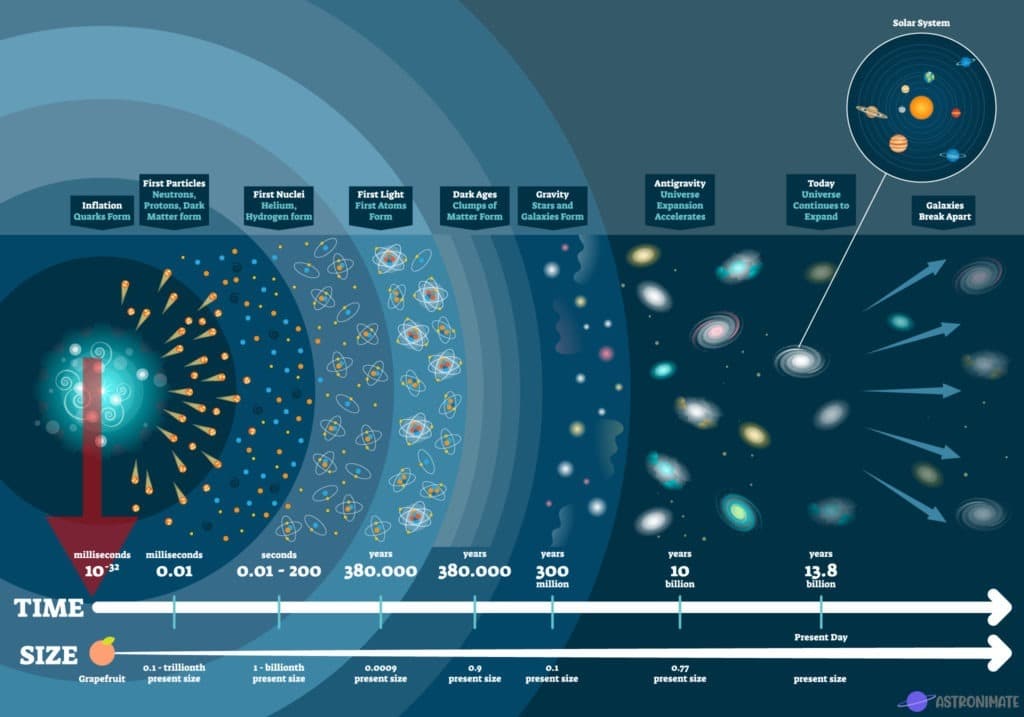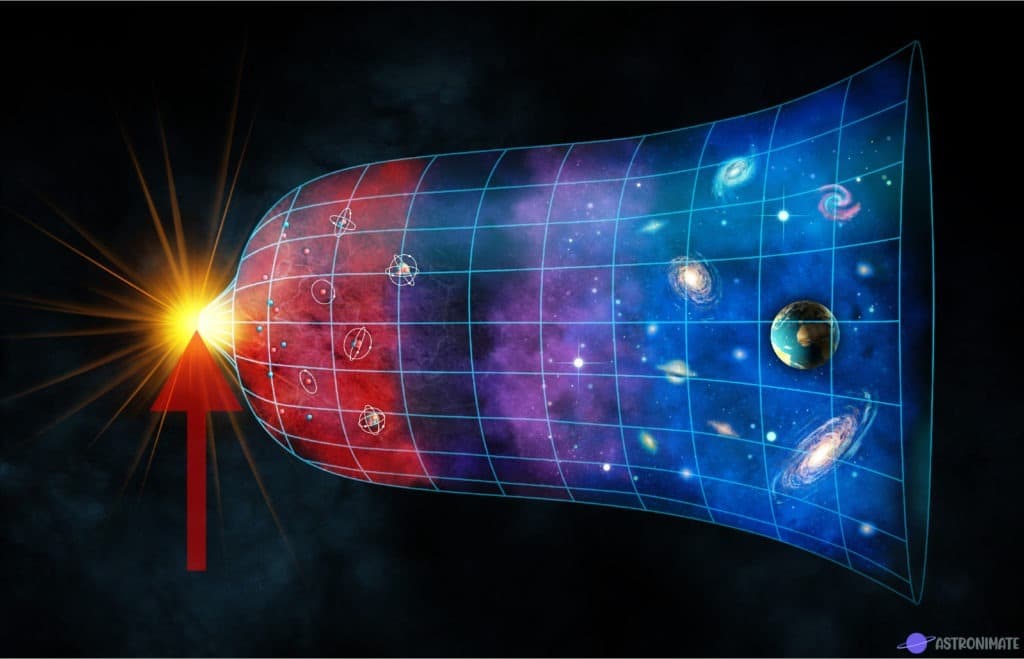This is your mission 02 of the epochs of the Universe.
The Grand Unified Theory is still part of the Big Bang.
So if you want to travel back in time and experience the Grand Unified Theory era, then this article is for you.
Let’s jump right in!
Mission 02 of the Epochs of the Universe – Big Bang
Astronomers and cosmologists have divided the development of the Universe into eras.
The Grand Unified Theory Era is the third epoch in the Universe’s evolution, following the Planck Era.
It is important to explore what happened in every era because there are big developments during each.
So, let’s dive into it and explore more about the Grand Unified Theory Era.
Mission Timeline – Grand Unified Theory Era

Mission Map – Grand Unified Theory Era

Mission Data – Grand Unified Theory Era
- Current Epoch: The Grand Unified Theory Era
- Age of the Universe: Between 10^-43 seconds and 10^-35 seconds
- Size of the Universe: Subatomic
- Current Temperature: Higher than 10^27 Kelvins
Mission Briefing – Grand Unified Theory Era
When you’re done exploring the Planck Era, you will reach the Grand Unified Theory Era. It occurs immediately after the Planck Era in a fraction of a second, between 10^-43 seconds and 10^-35 seconds.
In this epoch, we learn about the four fundamental forces of the Standard Model, with only three being unified:
- Strong force
- Electroweak force
- Electromagnetic force
So what’s the fourth one?
Gravity, but it’s not unified.
Did gravity split off from the other three fundamental interactions?
Has matter started forming?
Are galaxies and stars formed in this epoch?
Let’s get into more detail about what happens in this epoch:
What Do You See?
This epoch is part of the Big Bang because it occurred in stages. Since it is in the Planck Era, the size of the Universe in this epoch is still subatomic. There is some very slight change, but it is not observable.
You may wonder how this may be because we are now on the third epoch, and you would expect it to have increased in size, but understand that the expansion was gradual.
According to the Mission Data, you can see that the age of the Universe has changed.
The Grand Unified Theory Era occurred in a fraction of a second, between 10-43 seconds and 10-35 seconds. That is a very, very short time. It is difficult to fathom this small fraction of time.
Still, in this epoch, light has not been formed. Particles and molecules still cannot bind because of certain conditions like high temperature and high pressure.
The Universe is still utterly dark during this epoch. However, light is formed for the first time in the Universe between 240,000 and 300,000 years after the Big Bang.
When you look around, you don’t see galaxies and stars or anything at all. As stated earlier, particles and molecules did not exist because of certain conditions in the Universe:
- High temperature
- High density
The only difference that you can see in this epoch is the difference in age between the Planck Era and the Grand Unified Theory Era.
So why are we learning about this epoch anyway? We want to see some physical change as the Universe evolves.
What Do You Feel?
Now we will learn what happens in the Grand Unified Theory Era.
In this epoch, there are four fundamental forces in the Universe, as mentioned previously. The four forces are:
- Gravity
- Strong force
- Weak force
- Electromagnetic force
Gravity then separates from the other three fundamental forces because of temperature transition as the Universe expanded and cooled. This is just the same as water.
The way water turns to steam is the same way the fields that define the fundamental forces change when the temperature reaches a certain point.
Under these conditions of high temperature and density, three of the four fundamental forces—strong, weak, and electromagnetic forces—remain unified; that is, they exist as a single entity. Unfortunately, we don’t get to see this in our present Universe because it only happens at far higher temperatures.
These transitions in temperatures in the fundamental forces are caused by a phenomenon of quantum fields called symmetry breaking.
In this epoch, the Universe is still almost an invisible point. Well, it is not infinite as it was in the first epoch. It has increased in size, but the change is so tiny that you can barely notice the difference.
The temperature in this epoch is higher than 10^27 Kelvins. It is lower than the Planck Era because now the Universe has started to cool. Also, the density has changed slightly. As a result, the Universe is less dense than it is in the Planck Era.
Pressure is indirectly proportional to volume, so the pressure inside is very high, with the size of the Universe still being so small. So although it may be lower than it was in the Planck Era, it is still high.
What is Happening? Scientific Explanation
There is some scientific explanation in this epoch concerning the fundamental forces.
Appearance
Just as in the Planck Era, the size of the Universe is still nearly invisible. It is so microscopic that you cannot see it with the naked eye.
This epoch began with all the fundamental forces being unified. Then gravity splits off from the other three fundamental forces.
At the end of this era, the Grand Unified Theory predicts that the Universe cooled to the extent that the strong force separated from the fundamental forces resulting in the release of a tremendous amount of energy that led to the Universe’s rapid expansion.
After 10^36 seconds, the Universe might have grown from a subatomic size to the size of the solar system.
We will discuss more the rapid change in size in the next epoch.
Because the Universe is packed into a small space, temperature, density, and pressure are very high.
The temperature being 10^27 Kelvins. Particles and molecules cannot bind in such conditions. Galaxies, stars, and planets do not exist yet in the Grand Unified Theory Era for this reason.
Darkness still prevails in the Universe in this epoch because particles and molecules are not binding to form light.
Time
From the epochs of the Universe, the Grand Unified Theory Era follows the Planck Era. The epoch occurs between 10^-43 seconds and 10^-35 seconds after the Big Bang.
It might seem like a brief period, but some important developments occur during this period.
It is challenging to interpret how fundamental forces can unify and separate in such a very, very small fraction of time in the human mind.
This shows you that with every millisecond or second, that passes, many things happen without us noticing. Some may be visible to the naked eye, and some may not.
The time difference between the Grand Unified Theory Era and the Planck Era is concise, with a difference of about 10^-8 seconds.
Mission Summary – Grand Unified Theory Era
In summary, the Grand Unification Theory Era is all about the fundamental forces unifying and separating.
It began with gravity separating from the other three fundamental forces and then ended with the strong force separating from the electroweak force. This phase transition released a lot of energy that led to the rapid expansion of the Universe.
The epoch occurs in a fraction of a second, so it’s hard for the human brain to interpret how it could occur in such a brief period.
The density, temperature, and pressure parameters are still extremely high for particles and matter to exist. Thus, even light does not exist yet.
Now to see visible developments in terms of size and how the rapid expansion occurred, you can check out the next epoch, Electroweak Era.
Addition Mission Resources – The Grand Unified Theory Era
Here are some frequently asked questions about Mission 02, the Grand Unified Theory Era.
How Did the Fundamental Forces Interact?
From the beginning of this epoch, the four fundamental forces are unified. Then there was the first transition, where gravity separated because the Universe expanded and cooled. It crossed transitional temperature ranges causing gravity to separate from the rest.
The second phase of transition happened when the strong force split off from the electroweak force.
The phase transitions are caused by a phenomenon known in physics as symmetry breaking.
Why Was Gravity the First Force To Separate?
Gravity was the first force to separate from the other fundamental forces because it was the weakest in nature. Even the weak force was 10^28 times higher than gravity.
With the extremely high temperatures in the Universe, gravity would be affected.
What Is the Timeline of This Epoch?
The Grand Unified Theory Era happened between 10^-43 seconds and 10^-35 seconds after the Big Bang, which is 10^-8 seconds.
It is difficult for the human mind to understand how the unification and separation of fundamental forces happened in such a minuscule timeline.
Does Light Exist in This Epoch?
No, the Universe is still in total darkness.
Under such high heat and pressure conditions, particles could not form to produce light or even light elements.
Thus, in this epoch, matter did not exist.
What is the Phenomenon of Quantum Fields?
As the Universe continued to cool, there was a likelihood that the quantum fields that form the particles and forces in the Universe could settle at lower energy levels and with higher levels of stability, causing a shift in their interaction.
The quantum fields caused force interactions, so the Universe’s behavior changed when a phase transition occurs.
Does the Size of the Universe Change?
Yes, the size of the Universe does change, but the change is so minuscule that you can hardly notice it with the naked eye.
The size of the Universe is described as subatomic.
Epochs of the Universe: Mission Selection
- 00 – Big Bang
- 01 – Planck Era
- 02 – Grand Unified Theory Era (you’re here)
- 03 – Electroweak Era
- 04 – Particle Era
- 05 – Era of Nucleosynthesis
- 06 – Era of Nuclei
- 07 – Era of Atoms
- 08 – Era of Galaxies
